AWM41 995 - [Nurses Narratives] Sister G M Larkan - Part 1
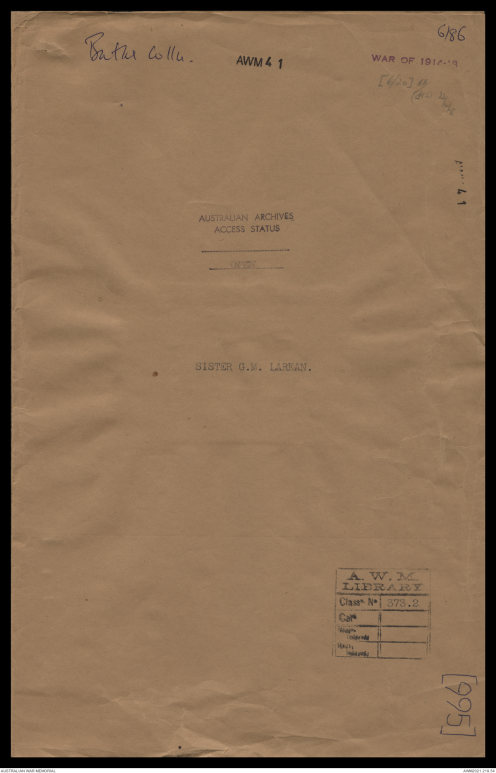

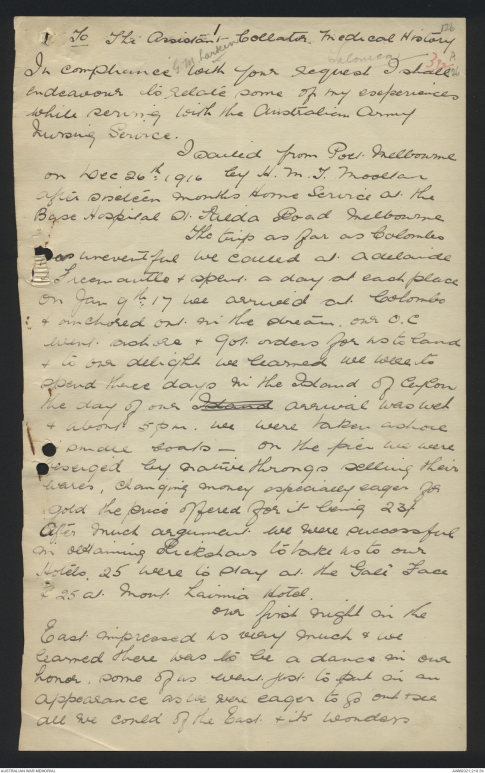
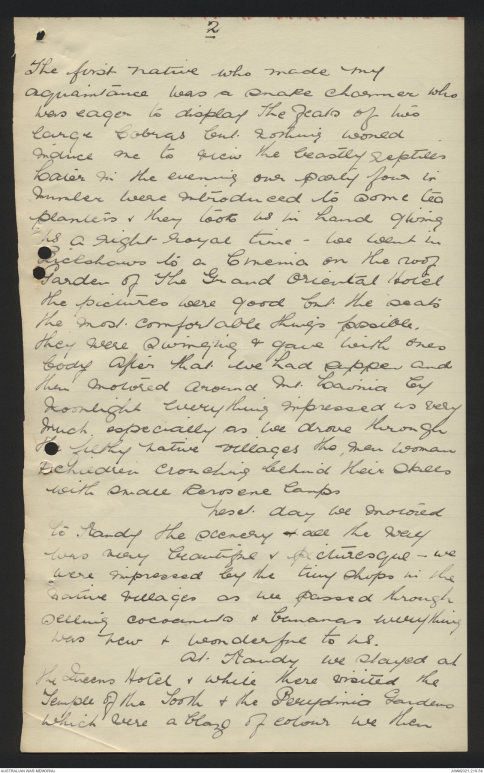
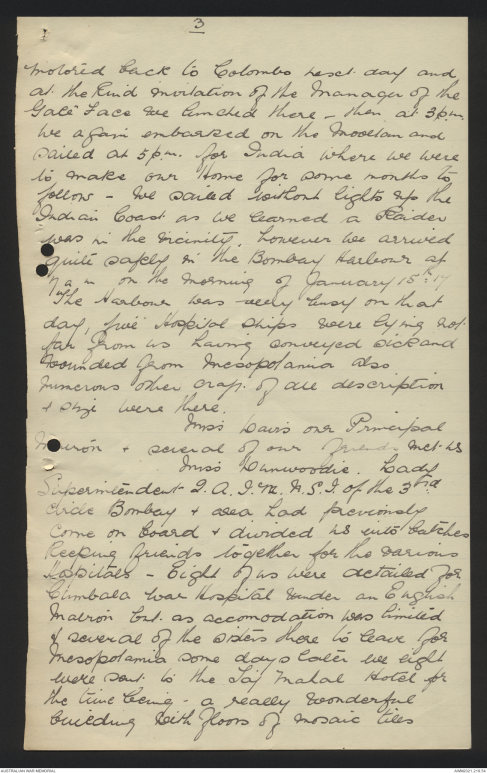
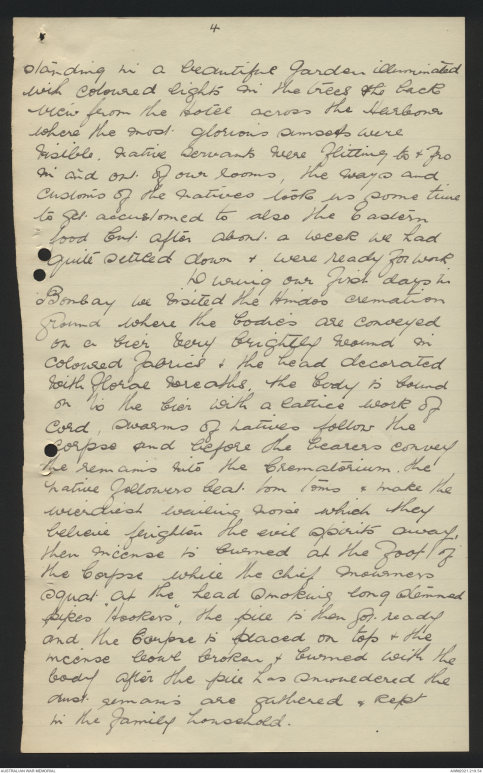

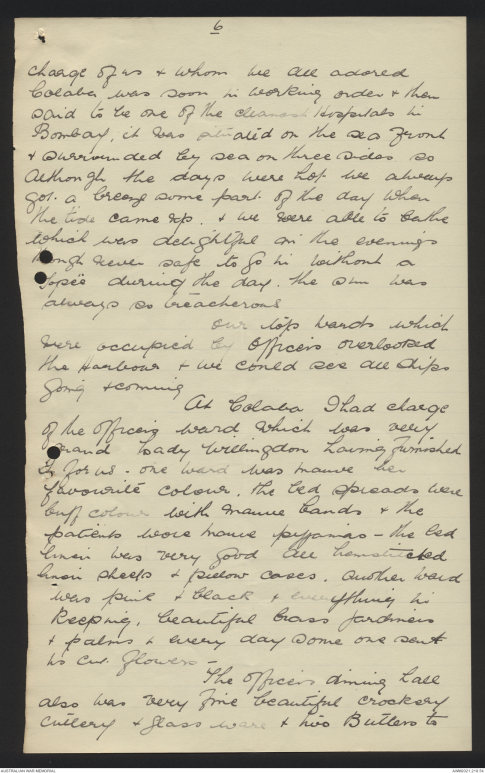
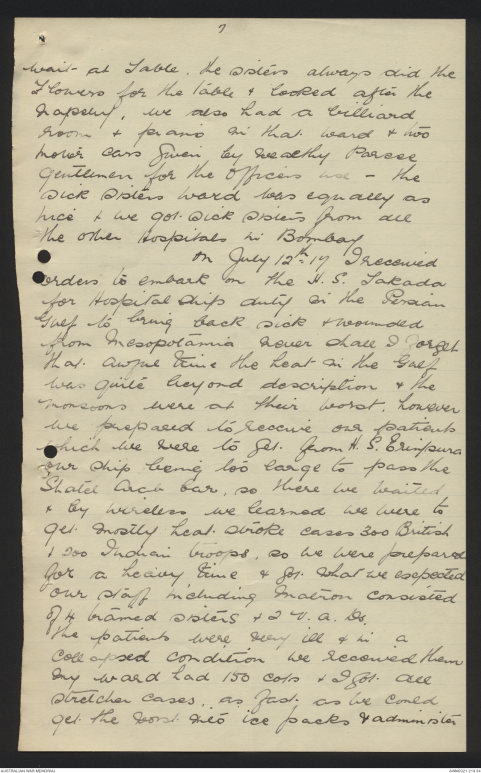
Butler Colln.
AWM 41
6186
[[?]]
WAR OF 1914-18
AUSTRALIAN ARCHIVES
ACCESS STATUS
OPEN
SISTER G.M.LARKAN.
A.W.M.
LIBRARY
Class No 373.2
[[?]]
[[?]]
[[?]]
[995]
The Official War Historian of the Commonwealth
Government (Dr. C.E.W. Bean), after his study of the
collection of private war records preserved in the Australian
War Memorial Library, wrote:
"The private diaries in this collection furnish some of the most
valuable historical records, but, like all private memories which were
not compiled with any historical purpose, they should not be
regarded as first-hand evidence except where it is certain that they
are so. The diarist is almost always sincere in his desire to record
accurately, but he is subject to no obligation or inducement to
indicate whether he is recording his own observations or incidents
told him by friends or heard at third or fourth hand at the mess-table.
Then, in some of the diaries in this collection, scenes described with
vivid detail, and without any warning that they are told at second or
third hand, have been found to be completely inaccurate in
important details. A certain number have also been written up
or revised long after the events, though doubtless usually from notes
made at the time. In most cases the student must rely on his
experience and on internal evidence to guide him in judging what is
and what is not likely to be historically accurate."
1 126
To the Assistant Collator Medical History
In compliance with your request I shall
endeavour to relate some of my experiences
while serving with the Australian Army
Nursing Service.
I sailed from Port Melbourne
on Dec 26th 1916 by H.M.T Mooltan
after sixteen months Home Service at the
Base Hospital St Kilda Road Melbourne
The trip as far as Colombo
was uneventful we called at Adelaide
Fremantle & spent a day at each place
On Jan 9th 17 we arrived at Colombo
& anchored out in the stream our O.C.
went ashore & got orders for us to land
& to our delight we learned we were to
spend three days in the Island of Ceylon
the day of our Island arrival was wet
& about 5pm. we were taken ashore
in small boats - on the pier we were
besieged by native throngs selling their
wares, changing money especially eager for
gold the price offered for it being 23/-
After much argument we were successful
in obtaining Rickshaws to take us to our
Hotels. 25 were to stay at the Gall Face
& 25 at Mont Laimia Hotel.
Our first night in the
East impressed us very much & we
learned there was to be a dance in our
honor. Some of us went just to put in an
appearance as we were eager to go out & see
all we could of the East & its wonders
2
The first Native who made my
acquaintance was a snake charmer who
was eager to display the feats of two
large Cobras but nothing would
induce one to view the beastly reptiles
Later in the evening our party four in
number were introduced to some tea
planters & they took us in hand giving
us a right royal time - we went in
Rickshaws to a Cinema on the roof
Garden of the Grand Oriental Hotel
the pictures were good but the seats
the most comfortable things possible.
They were swinging & gave with ones
body After that we had supper and
then motored around Mt Lavinia by
moonlight everything impressed us very
much especially as we drove through
the filthy native villages the men woman
& children crouching behind their stall
with small kerosene lamps.
Next day we motored
to Kandy the scenery all the way
was very beautiful & picturesque - we
were impressed by the tiny shops in the
native villages as we passed through
selling coconuts & bananas everything
was new & wonderful to us.
At Kandy we stayed at
the Queens Hotel & while there visited the
Temple of the Tooth & the Berydinia Gardens
which were a blaze of colour we then
3
motored back to Colombo next day and
at the kind invitation of the Manager if the
Gall Face we lunched there - then at 3pm.
We again embarked on the Mooltan and
sailed at 5p.m. for India where we were
to make our Home for some months to
follow - We sailed without lights up the
Indian Coast as we learned a Raider
was in the vicinity. however we arrived
quite safely in the Bombay Harbour at
7am on the morning of January 15th 17
The Harbour was very busy on that
day, five Hospital ships were lying not
far from us having conveyed sick and
wounded from Mesopotamia Also
numerous other craft of all description
& size were there.
Miss Davis our Principal
Matron & several of our friends met us
Miss Dunwoodie Lady
Superintendent I.A.I. 7th N.S.I of the 3rd
circle Bombay & area had previously
come on board & divided us into batches
keeping friends together for the various
hospitals - Eight of us were detailed for
Cumbala War Hospital under an English
Matron but as accommodation was limited
& several of the sisters there to leave for
Mesopotamia some days later we eight
were sent to the Taj Mahal Hotel for
the time being - a really wonderful
building with floors of mosaic tiles
4
standing in a beautiful garden illuminated
with coloured lights in the trees the back
view from the Hotel across the Harbour
where the most glorious sunsets were
visible. Native servants were flitting to & fro
in and out of our rooms, the ways and
customs of the natives took us some time
to get accustomed to also the Eastern
food but after about a week we had
quite settled down & were ready for work.
During our first days in
Bombay we visited the Hindus cremation
ground where the bodies are conveyed
on a bier very brightly wound in
coloured fabrics & the head decorated
with floral wreaths . the body is bound
on to the bier with a lattice work of
cord. Swarms of natives follow the
corpse and before the bearers convey
the remains into the Crematorium the
native followers beat tom toms & make the
wierdest wailing noise which they
believe frighten the evil spirits away,
then incense is burned at the foot of
the Corpse while the chief Mourners
squat at the head smoking long stemmed
pipes "Hookers", the pire is then got ready
and the Corpse is placed on top & the
incense bowl broken & burned with the
body After the pire has smouldered the
dust remains are gathered & kept
in the family household.
5.
The Parsees have a different way of disposing
with their dead. the corpse is carried
through the street in a sitting position
the face exposed & the body is conveyed
in a sort of canopy to the Tower of
Silence which no one but the Parsees can
enter, the Public are admitted on a special
pass but are just shown a miniature
example of the Tower, the corpse is placed
on a grating in the Tower & huge [[Mulchers?]]
(very large birds) are admitted through
a trap door they pick all the flesh
from the bones which are them exposed
& dried by the sun & face through the
Grating into the Tower.
We commenced duty at
Cumbala War Hospital on Malabar Hill
the surgical cases there were very
heavy. In my ward mostly spine
& head from Mesopotamia after the
advance on that. after three weeks
duty there we learned we were to be
transferred to Colaba War Hospital in
Bombay. The English matrons decided
it would be better to keep Australian
sisters together so we were given Colaba
for our Hospital. The personnel of which
were L.A.M.C. the Hospital was in a
very dilapidated condition when we
went there but after about a month
under Miss Hirapp an Indian Regular
Matron I.A.I.M.N.S.I who came to take
6.
charge of us & whom we all adored
Colaba was soon in working order & then
said to be one of the cleanest Hospitals in
Bombay , it was situated on the sea front
& surrounded by sea on three sides so
Although the days were hot we always
got a breeze some part of the day when
the tide came up & we were able to bathe
which was delightful in the evenings
though never safe to go in without a
Topse during the day. The sun was
always so treacherous.
Our top wards which
were occupied by Officers overlooked
the Harbour & we would see all the ships
going & coming.
At Colaba I had charge
of the Officers ward which was very
grand. Lady Willingdon having furnished
it for us. One ward was mauve her
favourite colour. The bed spreads were
buff colour with mauve bands & the
patients wore mauve pyjamas - the bed
linen was very good homestitched
linen sheets & pillow cases. Another ward
was pink & black & everything in
keeping, beautiful brass jardiniers
& palms & every day some one sent
us cut flowers.
The officers dining hall
also was very fine beautiful crockery
cutlery & glass ware & two Butlers to
7
wait at Table. The sisters always did the
Flowers for the table & looked after the
Napery, we also had a billiard
room & piano in that ward & two
motor cars given by the wealthy Parsee
gentlemen for the officers use - the
sick sisters ward was equally as
nice & we got sick sisters from all
the other Hospitals in Bombay.
On July 12th 19 I received
orders to embark on the H.S. Takada
for Hospital Ship duty in the Persian
Gulf to bring back sick & wounded
from Mesopotamia never shall I forget
that awful time & the heat in the Gulf
was quite beyond description & the
monsoons were at their worst, however
we prepared to receive our patients
which we were to get from H.S. Erinpura
our ship being too large to pass the
Shatel Arch bar, so there we waited
& by wireless we learned we were to
get mostly heat stroke cases 300 British
& 200 Indian troops, so we were prepared
for a heavy time & got what we expected
our staff including Matron consisted
of 4 trained sisters & 2 V.A.Ds.
The patients were very ill & in a
collapsed condition we received them
My ward had 150 cots & I got all
stretcher cases, as fast as we would
get the worst into ice packs & administer
 Sam scott
Sam scottThis transcription item is now locked to you for editing. To release the lock either Save your changes or Cancel.
This lock will be automatically released after 60 minutes of inactivity.